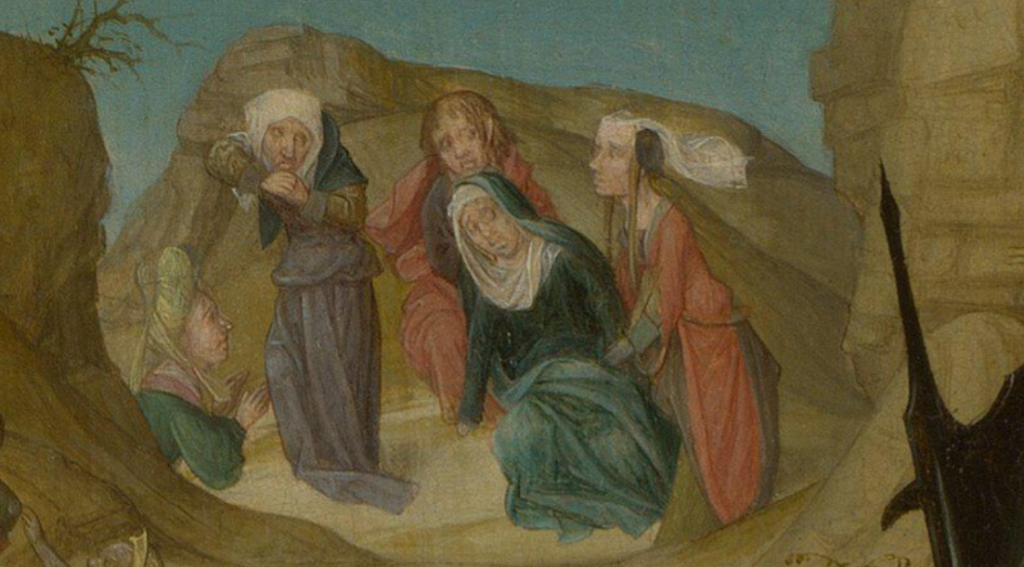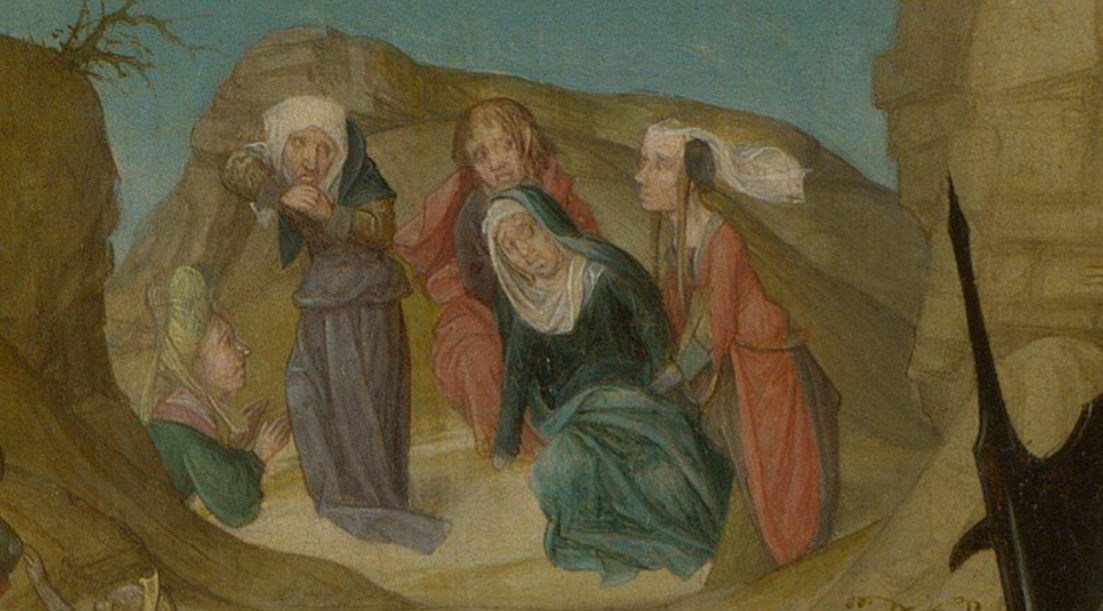I have often wondered about this group of exiles – I’m never entirely clear where they are supposed to be, or what they are doing there. They form no part of the narrative with which I am familiar, and so, from my point of view, they are open to interpretation. However, their identity is not. They are so far away that the details are not precise – partly, you might think, because of the perspective, and indeed, they are so small that the detailing would be tricky for any but the most meticulous artist. And, as you may have noticed, the Master of Delft prefers a broader brushstroke to, say, Jan van Eyck. But then, compared to Jan van Eyck, most artists do!

Slumped in the centre is the Virgin Mary, wearing a blue robe and blue cloak, the latter of which goes over her head and partially covers her white headdress, or veil. This falls down one side of her head, wraps around and goes over her chest thus framing her face, which, however small, is full of sorrow. Her posture is unclear – she might be collapsing, fainting from grief, or she may simply be sitting on a small mound, leaning on her right hand. Behind her, supporting her morally if not actually physically, is St John the Evangelist. We know it must be a man as his long hair is neither covered nor dressed, and John, who usually wears red, is the constant companion of the Virgin at the Crucifixion. Behind her, holding her left hand, is a woman in red, her white headdress flying out behind her, suggesting that there is a strong breeze. Her red hair hangs in long bunches on either side of her face. This is Mary Magdalene, who has her hair dressed, but not entirely covered, a hint of the disreputable past which the Catholic Church attributed to her for the vast majority of church history – from 591 to 1969, to be precise. I know I’ve lectured about this more than once this year, but I’m sure I have also written about it. However, I can’t track it down to give you a link, so I shall come back to the subject again!

Gathered together we see the Virgin Mary, St John the Evangelist and St Mary Magdalene – with two other women. One is dressed in purple, which might suggest a royal connection, but I suspect that here it is an artistic choice to distinguish her from the others. She has a white headdress, black collar or cloak, and yellow, possibly gold sleeves. Her gesture of clasped hands and extended elbows is one used to suggest extreme grief. The other woman, presumably on her knees behind the left-hand hillock, leans in towards the Virgin with a gesture of concern. A clue to their identity can be gleaned from Mathew 27: 55-56,
And many women were there beholding afar off, which followed Jesus from Galilee, ministering unto him: Among which was Mary Magdalene, and Mary the mother of James and Joses, and the mother of Zebedees children.
I wrote about these women at some length, and not a little confusion, some time ago (see 109 – Death and Resurrection – despite what I say it may help…). In medieval tradition ‘Mary the mother of James and Joses’ was identified with Mary Cleophas, who John (19:25) says was Jesus’s ‘mother’s sister’. Did you know the Virgin had sister? At this point in the narrative Mark 15:40 says much the same as Matthew:
There were also women looking on afar off: among whom was Mary Magdalene, and Mary the mother of James the less and of Joses, and Salome.
This text was used to identify ‘the mother of Zebedees children’ with a woman known as Mary Salome. The relationships were explained (in the Golden Legend, among other places) by the story that, after the Virgin Mary had been born, her father Joachim died, and Anna married a man called Cleophas. They had a daughter they named Mary. When Cleophas died, Anna married a third time, to a man called Salomas, and they too had a daughter called Mary. So gathered in this group are four Maries and a John, the Maries being the Virgin, the Magdalene, Mary Cleophas and Mary Salome – though of the last two I would hesitate to say which is which. But what about the questions which opened this post? Where are they? And what are they doing? Quite simply, in four words from Mark, they are ‘looking on afar off.’ As yet, they haven’t summoned up the courage to get closer. But they will.


Today’s Post is particularly rich with fascinating insight and absorbing information in the links : marvellous ! Thank you so much. Julia
LikeLiked by 2 people
Thank you, as ever!
LikeLiked by 1 person
I was going to say “The Three Marys” – the ones at the crucifixion, rather than the ones at the empty tomb – but you have identified all four: the three sometimes considered to be daughters of Saint Anne, plus Mary Magdalene, and also a bonus man as a chaperone, all looking on from afar.
Would it be out of place to mention the Holy Kinship?
I have a feeling we might be seeing some of these characters again soon…
LikeLike
Well, the identification of the Maries is part of the Holy Kinship, so, no, it wouldn’t be out of place! Plus, there are more women to come… and yes, they may be back!
LikeLiked by 1 person